The Rise of RAS
50% of the world's fish production can be attributed to aquaculture which is the fastest growing food production sector in the world. In 2022 the global RAS market was $4.459 billion and is projected to reach $8.246 billion by 2028.
Dozens of RAS projects were planned in 2019 but very few have begun construction or development, primarily due to investment barriers.
Key Investor Concerns & Risk Factors
Factors preventing projects being built include permitting, local opposition/social license, complicated infrastructure requirements, lack of success of others, perceived high risk and challenges securing investment. The biggest of these issues are risk and cost and with no recent success stories to point to, the barrier for investors is large. There is good potential profit after repayment of capex and as long as you execute as planned and don’t have any big upsets or failures.
Aquaculture comes with a unique set of risks, mainly stemming from its capital-intensive nature and the possibility of disease wiping out farmed fish populations. When all these risks are added together, RAS is perceived as a high-risk investment. As such, risk mitigation efforts are key to boosting investor comfort and interest.
Modularization Benefits
Modularization refers to groups of modules, interfaces, and rules that enable the configuration of products. Success of a modular solution is built upon the ideas of flexibility, agility, and efficiency.
Modularization in RAS is not new, but a modular design approach is foundational in RAS and provides the following benefits:
- Distribution of risk
- Scaling efficiency
- Improved design and constructability
- Supply chain benefits
- Commonality of operating method
- Commonality of components
Efficiency
Enables an economy of scale and stability, consolidation of supply chain volumes, and the ability to incrementally improve.
Flexibility
Enables mass customization for specific customer needs and allows for highly efficient configuration tools to make cost estimates faster and more accurate.
Agility
Allows for swift and controlled changes for new requirements and/or technologies.
Custom vs. Standard
Historically projects have been highly customized due to high variation in species, production scale, target size, water quality targets, etc. Businesses want to differentiate and therefore desire a unique solution, however, the drive for custom is not addressing the investor needs for reduced risk and reduced cost. A lack of standardization can slow the growth of technology and the industry.
Standardization directly addresses key investor concerns and can be seen as an indicator of industry maturity.
| Custom Solution | Standard Solution | |
|---|---|---|
| Tailored to specific requirements | Yes | No |
| Incemental Improvement (Quality / Delivery / Cost) | No | Yes |
| Optimization (Value / Constructability / Efficiency) | Low | High |
| Lead Time (Design / Construction / Startup) | High | Low |
| Confidence (Performance / Cost) | Low | High |
| Overall Cost | High | Low |
| Overall Risk | High | Low |
Standardization Goals
A key goal of standardization is to achieve the best outcome at the best possible price, considering not only the minimum purchase price, but also the maximum efficiency and effectiveness of the purchase. Highly optimized RAS modules will have all components dimensioned to work harmoniously at their peak output, thereby maximizing value for money.
Value for money is a core principle. It means achieving a desired outcome at the best possible price, based on a balanced judgement of financial and non-financial factors.
In the development of standard modules, designer should seek to maximize the value for money in order to:
- Optimize efficiency
- Optimize use of capital
- Achieve the best relative dimensioning of components to get the best overall outcome
As an example, if we consider using the maximum capacity of a drum filter model, then scale the maximum production based on that equipment so you are utilizing its full capacity.
CAPEX & Standardization
Typically, the aquaculture design and aquaculture equipment for a RAS project is 35% - 45% of the total CAPEX, but it is arguably the most important part of the project cost as it accounts for 100% of the production requirements, 60% of the project timeline, 95% of the power requirements and 90% of the operational risks. Therefore, it makes sense to focus standardization efforts on where it will have the biggest impact.
The use of standard modules to build at scale is a long-established practice in agriculture and is common in poultry, hog and cattle production. For RAS, once standard modules are established, they should be leveraged as much as possible to get the best use of your capital to utilize the most productivity from the system.
RAS Project CAPEX
What is Bioplanning?
Bioplanning is the planning of fish production to determine the foundational design criteria for the facility. It is a complex multi-variable optimization exercise with many solutions that will achieve the target production. Navigating these variables and their implications requires a broad experience base, multi-disciplinary knowledge, and a deep understanding of the interactions between various criteria and decisions. The result of the bioplanning exercise will balance flexibility, efficiency, cost, complexity, and production risk. Bioplanning provides the largest opportunity to drive the economics of the farm and to mitigate production risk.
The decisions made during bioplanning heavily influence the balance between required CAPEX and risk. The bioplan must be developed to achieve the optimal balance of risk, complexity and CAPEX for the project owner. However, it's important that you don't just consider the lowest CAPEX but find a balance to ensure the success of the project.
An Alternate Design Strategy
An alternate design strategy that PR Aqua uses is to utilize the maximum efficiency of the standard RAS building blocks and then develop a bioplan and farm design that maximizes the production from standardized RAS modules.
By constraining the bioplan to use standard building blocks that you know are highly capital and production efficient, you maximize the production through strategically using the standard modules. This results in not having to build custom modules to meet the criteria developed by an independently derived bioplan.
Strategic Differentiation
Businesses can still differentiate at the strategic level while leveraging standardized modular systems. Doing so can provide both bioplanning and business plan advantages.
Bioplanning Advantage
- Customized bioplans leveraging highly optimized standardized design elements
- Unique balance of flexibility, efficiency, cost, complexity, and production risk
Business Plan Advantage
- Unique marketing
- Unique product offering
- Location advantages
- Synergy with other business
- Community support
- Government support
Discuss Your Project
No matter how big or how small, or how far along your plans are, we can help. PR Aqua's technical knowledge and client commitment are second to none. Let's get started!









